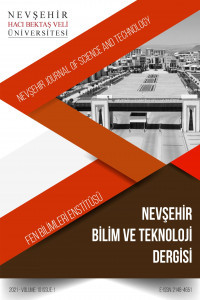AlSiCu (LM24) Alüminyum Alaşımında Modifikasyon ve Tane İnceltmenin Mikroyapı ve Mekanik Özelliklere Etkisi
Al-Si-Cu alaşımı, modifikasyon, tane inceltme
The Effect of Modification and Grain Refining on Microstructure and Mechanical Properties of AlSiCu (LM24) Aluminum Alloy
Al-Si-Cu alloys, modification, grain refinement,
___
- Referans1 Rathi, S.K., Sharma, A., Di Sabatino A., “Effect of mould temperature, grain refinement and modification on hot tearing test in Al-7Si-3Cu alloy” Engineering Failure Analysis, 79, 592–605, 2017.
- Referans2 Campbell, J., “Complete Casting Handbook Metal Casting Processes”, Metallurgy, Techniques and Design, Oxford, 2010.
- Referans3 Birol, Y., “An improved practice to manufacture Al–Ti–B master alloys by reacting halide salts with molten aluminium” Journal of Alloys and Compounds, 420, 71–76, 2006.
- Referans4 Birol, Y., “A novel Al–Ti–B alloy for grain refining Al–Si foundry alloys”, Journal of Alloys and Compounds, 486 219–222, 2009.
- Referans5 D’Elia, F., Ravindran, C., “Influence of grain refinement on hot tearing in B206 and A319 aluminum alloys”, Transactions of The Indian Institute of Metals, 62, 315-319, 2009.
- Referans6 Timelli, G., Camicia, G., Ferraro S., “Effect of grain refinement and cooling rate on the microstructure and mechanical properties of secondary Al-Si-Cu alloys”, Journal of Materials Engineering and Performance, 611-621, 2014.
- Referans7 Wang, E., Gao, T., Nie, J., Liu. X., “Grain refinement limit and mechanical properties of 6063 alloy inoculated by Al–Ti–C (B) master alloys”, Journal of Alloys and Compounds, 594, 7–11, 2014.
- ISSN: 2148-466X
- Yayın Aralığı: Yılda 2 Sayı
- Başlangıç: 2012
- Yayıncı: Nevşehir Hacı Bektaş Veli Üniversitesi
Application of Fourier Transform Infrared (FTIR) Spectroscopy to Analysis of Clays
Elektroeğirme Yöntemiyle Ag Katkılı Karbon Nanoliflerin Sentezi
Atilla EVCİN, Bahri ERSOY, Nalan ÇİÇEK BEZİR
LM6 Alüminyum Alaşımlarında Zr’nin Etkisi
Farklı Presleme Basınçları İle Üretilen Toz Metal Çeliklerin Aşınma Davranışlarının Belirlenmesi
İjlal ŞİMŞEK, Dursun ÖZYÜREK, Doğan ŞİMŞEK
Alime ÇOLAK, Ferda MİNDİVAN, Meryem GÖKTAŞ
Saltuk Alper YAŞAR, Gültekin UZUN, İhsan KORKUT
Inverse Gas Chromatographic Determination of the Surface Properties of ZSM-5 Zeolite
Elektrolitik Kaplanmış Nikel/Grafen Kompozit Kaplamaların Üretimi ve Karakterizasyonu
Ferda MİNDİVAN, Kemal AYDIN, Harun MİNDİVAN
Rize yöresi obsidyeninin çimentonun hidratasyon ısısına etkisi
